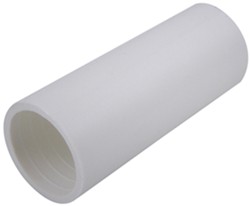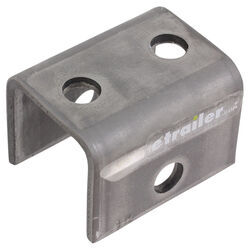
How to Determine Axle Placement on a Custom 5 x 9 ATV and Motorcycle Trailer
Question:
Hi, I am building a 5x9 atv/ motorcycle trailer by emulating an 80s Cox 4x8. The axle was centered on the Cox and so assuming thats ok for the new one. I saw the math equasion shown here but its a little over my head, most small trailers I see seem the have centered axles except boat trailers. The tongue of course makes it a little front heavy and I always keep the load forward. Would there be any benefit to moving the axle 6inch or a ft behind center? Also the replacement hangers sold here are a half inch shallower than the Cox but do fit the spring so Im assuming thats ok? Also, the front of the spring is a circle with a short plastic bushing on either side of the eye. The rear of the spring has an elongated c shape with a bolt and bushing that the spring rests against. This bolt and bushing must take a beating and friction everytime I hit a bump. How has it lasted 20 yrs.? The rear bolt has a flat side in the middle and I think the bushing was triangular. Can u suggest a replacement part for new bushings and bolts as I am trying to not have slop in the reused parts. I forgot to take pics earlier but ill post what I have of the old trailer as I was salvaging the axle and springs. Thanks
asked by: Wm H
Expert Reply:
When determining the axle placement on a trailer, an important factor to consider is the tongue weight. You want the tongue weight of the trailer to be approximately 10 percent of the gross trailer weight. Moving the axle rearward will increase the tongue weight of the trailer. A heavy tongue weight could cause issues with traction and sway when towing, but that is not as much of a concern on smaller trailers than it is on larger travel trailers or enclosed trailers.
First, we want to know the weight capacity of your axle. We will use this as the total weight. Next, we will want to determine how much weight you plan on loading on the front of the trailer that will directly affect the tongue weight. For example, if you plan on loading a 500 lb ATV at the front of the trailer, then your tongue weight will be closer to 500 lbs. This will be your tongue weight. After that, we can follow the formula on the attached photo. For D we can use the original axle placement. D is the measurement from the center of the axle to the front of the trailer tongue. The formula will tell use whether to move the axle forward or backward for your tongue weight. If you think your tongue weight will be greater than 10 percent of the axle capacity, then you will want to use the column on the left.
Using slightly shorter leaf spring hangers is okay, but it will decrease the ground clearance of the trailer. You will also want to remember that it will bring the axle that much closer to the trailer frame and the wheel closer to the fender. Our leaf spring hangers are measured from the top of the hanger to the center of the bolt hole. If your hangers have an overall measurement of 2 inches, then they are likely the same size as the leaf spring hanger, part # 115917, that you referenced.
In your pictures, it appears that the frame was cut out around the leaf spring hangers. That will create a weak point in the frame so I recommend repairing those holes if possible if you plan on using the trailer in the picture. You could move the axle 6 inches to 1 ft rearward, but again, that will increase the tongue weight of the trailer, especially if the cargo is loaded toward the front of the trailer.
Also, I noticed the axle was mounted under the leaf springs. Flipping the axle is common, but axles are built with a slight bow that allows the axle to flatten when a load is put on the trailer. Looking at your photo, it appears the bow may be pointing toward the ground now (if the trailer were right side up). If this is the case, you will want to flip the axle so the bow is pointing toward the trailer, not the ground.
For replacement bushings and shackle bolts, you will want to verify the size of the bolts you currently have. You can determine this by either the bolt or by the bolt holes on the hangers. Most trailers use 9/16 inch shackle bolts like part # 166081, with a 11/16 inch outer diameter bushing, # TRBU11566. You can determine the correct diameter of the bushing by measuring the bolt hole eye of the leaf spring. You can use the same bolt and bushing for the front and rear of the leaf spring. It is surprising that the same shackle bolt and bushing have lasted for 20 years, but if they were designed to work with different types of trailers, from small open utility trailers to large travel trailers and equipment trailers.

Products Referenced in This Question
Shackle Bolt with Locknut for Double-Eye Springs - 3" Long
- Trailer Leaf Spring Suspension
- Suspension Bolts
- Camper
- Car Hauler
- Utility Trailer
- 9/16 Inch Diameter
- 3 Inch Long
- ABS Fasteners
more information >
Nylon Bushing - 9/16" Inner Diameter, 11/16" Outer Diameter - 1-3/4" Long
- Trailer Leaf Spring Suspension
- Bushings
- Boat Trailer
- Camper
- Car Hauler
- Snowmobile Trailer
- Utility Trailer
- 9/16 Inch ID x 11/16 Inch OD
- 1-3/4 Inch Long
- TruRyde
more information >
Product Page this Question was Asked From
Front/Rear Hanger for Double-Eye Springs - 1-5/16" Tall - 9/16" Bolt Hole
- Trailer Leaf Spring Suspension
- Hangers
- Camper
- Car Hauler
- Utility Trailer
- Double Eye Springs
- 9/16 Inch Diameter
- 1-1/2 Inch Tall
- Single Axle
- Tandem Axle
- Triple Axle
- etrailer
more information >

Continue Researching
- Article: Double-Eye Trailer Suspension System Review
- Shop: Dexter Heavy-Duty Shackle Link for 1-3/4" Wide Double Eye Spring Suspension Kit - Qty 1
- Shop: Nylon Bushing - 9/16" Inner Diameter, 11/16" Outer Diameter - 1-3/4" Long
- Shop: Replacement Shackle Strap - 2-5/8" Long
- Shop: CE Smith Shackle Strap - Galvanized Steel - 2-3/4" Hole-to-Hole Length
- Search Results: e54sr
- Search Results: nylon leaf spring bushings
- Search Results: nylon bushings
- Q&A: How Tight Should Shackle Link Nuts Be On Trailer Suspension
- Q&A: Trailer Leaf Spring Bushings with 9/16 Inner Diameter and 3/4 Outer Diameter
- Video: etrailer Trailer Suspension 115052 Review
- Video: Redline Trailer Suspension SP05-060 Review
- Video: Review of Dexter Axle Trailer Leaf Spring Suspension - Replacement Shackle Link - DX55FR
- Shop: Suspension Bushing - Nylon
- Shop: Suspension Kit for Tandem-Axle Trailers - 1-3/4" Wide Double Eye Springs - 2-1/4" Links
- Shop: Curved Equalizer for 1-3/4" Wide Double-Eye Springs - 5-3/4" Long - 9/16" Center Hole
- Video: Redline Trailer Suspension 166081 Review
- Video: MORryde Tandem Axle Trailer Rubber Equalizers Installation
- Q&A: What is Minimum Trailer Axle to Frame Clearance for Leaf Spring Deflection
- Q&A: Will Putting Axle In Backwards Cause Trailer Brakes To Not Function?
- Q&A: Gaps Between Shackle Bolt Heads and Shackles on Double-Eye Trailer Suspension
- Q&A: Upgrading Trailer Bushings Greasable Bolts and Equalizer Suspension Parts on a Alpenlite 5th Wheel
- Search Results: bushings
- Search Results: break away system
- Search Results: electric brake break away
- Search Results: trsl225
- Video: Dexter Nylon Suspension Bushing Installation
- Shop: Vehicle Tow Bar Brake System
- Video: etrailer Trailer Suspension - Leaf Spring Suspension - AP233 Review
- Q&A: Torque Specs for Axle Spindle Nut, Suspension Hanger Bolts, and Lug Nuts for Trailer










